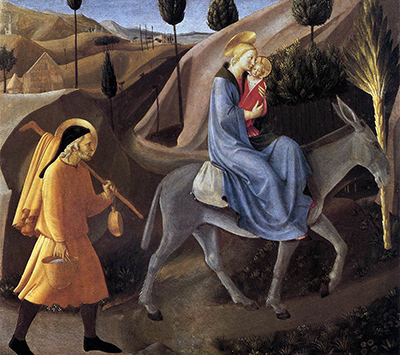This well crafted scene came towards the end of Fra Angelico's career. It is a relatively small piece at around 38cm in width and height and resides today in the San Marco Museum in Florence, Italy. They give it an approximate date of around 1451-1452.
The classic image of the Flight into Egypt features mother and child travelling by donkey whilst Joseph follows on from behind. She is wearing blue, helping us to identify her, and Fra Angelico would normally paint the Virgin in blue clothing for this very purpose. She leans forward in this composition, perhaps starting to tire as the journey continues, whilst still holding her child aloft to keep him safe. Joseph wears a mustard coloured outfit which perhaps was chosen because of how it complements the blue tones elsewhere, rather than serving any symbolic purpose itself. Behind these figures we then see a sprawling landscape which reminds us of the journey that they are on as well as adding aesthetic interest to the rest of the painting. The artist had spent years perfecting his use of landscape art, even though this genre up to that point was always used as a supporting feature rather than as a specialisation which occurred several centuries later with the Romanticist painters (Constable, Turner, Friedrich), as well as slightly earlier artists such as Claude Lorrain.
The halos used in this depiction are adapted to the angle and size of the figures, where as in previous decades Fra Angelico would actually work in a much more flat manner. The newer approach found within Flight into Egypt makes everything feel a little more real and helps us to really enter the scene within our own minds, and feel a part of this long and tiring journey. This change helps to symbolise many changes that happened as the Middle Ages moved into the Italian Renaissance, where perspective would change and become far more advanced in how artists captured the different layers of an artwork, moving from the foreground to the background.
The Museo di San Marco offers yet another exciting avenue of cultural discovery within the exciting and historic city of Florence, Italy. This location is considered an essential element to the start of the Italian Renaissance and many of its most important artworks still reside there today across some of the permanent collections. For the culturally-minded, there also still remains a good selection of architecture from the same periods, as well as a number of sculptures too. One can learn so much about this important period in European art history by fitting in a selection of these different venues, some of which remain working churches, whilst others are purpose built galleries and museums. Followers of Fra Angelico should also search out some of his alternative depictions of the Annunciation, many of which are more famous and complex than the alternative theme displayed here.




